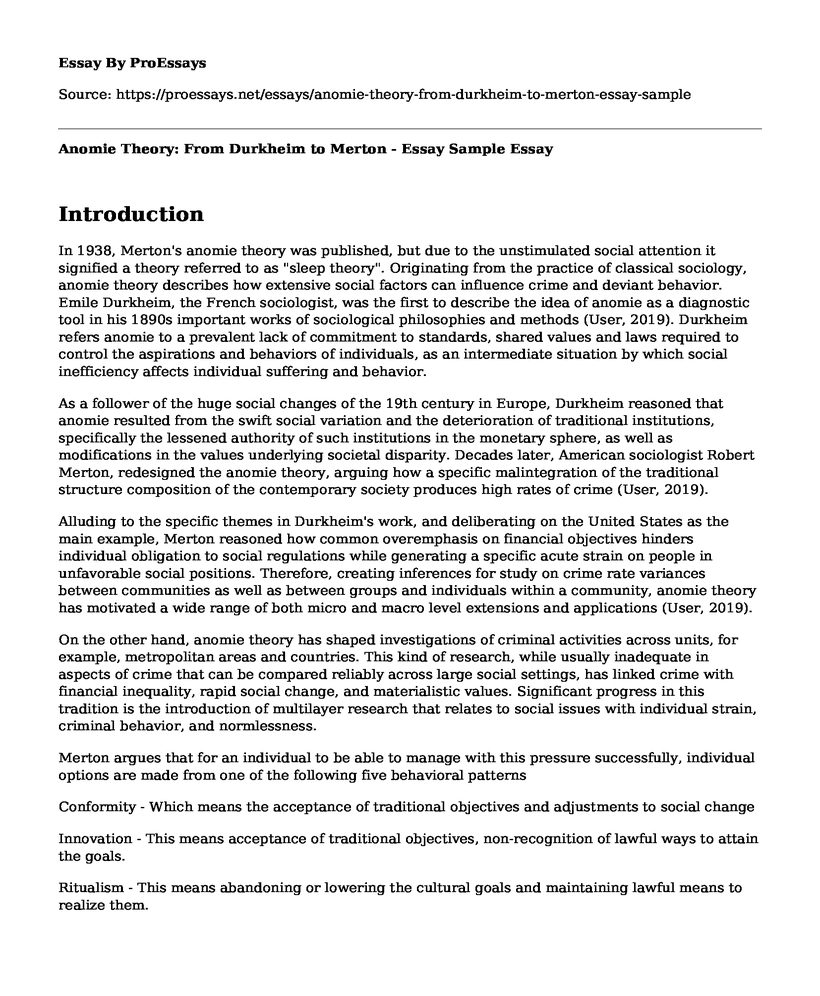Introduction
In 1938, Merton's anomie theory was published, but due to the unstimulated social attention it signified a theory referred to as "sleep theory". Originating from the practice of classical sociology, anomie theory describes how extensive social factors can influence crime and deviant behavior. Emile Durkheim, the French sociologist, was the first to describe the idea of anomie as a diagnostic tool in his 1890s important works of sociological philosophies and methods (User, 2019). Durkheim refers anomie to a prevalent lack of commitment to standards, shared values and laws required to control the aspirations and behaviors of individuals, as an intermediate situation by which social inefficiency affects individual suffering and behavior.
As a follower of the huge social changes of the 19th century in Europe, Durkheim reasoned that anomie resulted from the swift social variation and the deterioration of traditional institutions, specifically the lessened authority of such institutions in the monetary sphere, as well as modifications in the values underlying societal disparity. Decades later, American sociologist Robert Merton, redesigned the anomie theory, arguing how a specific malintegration of the traditional structure composition of the contemporary society produces high rates of crime (User, 2019).
Alluding to the specific themes in Durkheim's work, and deliberating on the United States as the main example, Merton reasoned how common overemphasis on financial objectives hinders individual obligation to social regulations while generating a specific acute strain on people in unfavorable social positions. Therefore, creating inferences for study on crime rate variances between communities as well as between groups and individuals within a community, anomie theory has motivated a wide range of both micro and macro level extensions and applications (User, 2019).
On the other hand, anomie theory has shaped investigations of criminal activities across units, for example, metropolitan areas and countries. This kind of research, while usually inadequate in aspects of crime that can be compared reliably across large social settings, has linked crime with financial inequality, rapid social change, and materialistic values. Significant progress in this tradition is the introduction of multilayer research that relates to social issues with individual strain, criminal behavior, and normlessness.
Merton argues that for an individual to be able to manage with this pressure successfully, individual options are made from one of the following five behavioral patterns
Conformity - Which means the acceptance of traditional objectives and adjustments to social change
Innovation - This means acceptance of traditional objectives, non-recognition of lawful ways to attain the goals.
Ritualism - This means abandoning or lowering the cultural goals and maintaining lawful means to realize them.
Retreatism - Which means rejection of traditional norms and permissible means
Rebellion - This means combating the means and objectives to alter existing social settings.
Additionally, anomie theory has been applied and extensively used in research on corporate, white-collar crime and business in the private sector. While it's essential to carry out more research in this area, the existing work shows how anomie theory delivers a specified potent description of high-level differences in corporate and business crime like bribery In future, it is possible to conduct research that may lead to an integration of micro-level and macro-level applications and extensions.
Conclusion
In conclusion, therefore, Merton's anomie theory is primarily practical in nature; people engage in criminal activities because sthey lack alternative options. In this context, therefore, Merton explains economic crimes like burglary or robbery but not crimes such as rape or murder. Due to the lack of accessible legitimate ways to accomplish goals, Merton describes crime only inside the lower class, because it is assumed that the upper and middle class have these resources at their disposal.
Reference
User, S. (2019). Anomie Theory: Emile Durkheim. Retrieved 14 October 2019, from https://www.legalmetro.com/library/anomie-theory-emile-durkheim
Cite this page
Anomie Theory: From Durkheim to Merton - Essay Sample. (2023, Feb 27). Retrieved from https://proessays.net/essays/anomie-theory-from-durkheim-to-merton-essay-sample
If you are the original author of this essay and no longer wish to have it published on the ProEssays website, please click below to request its removal:
- The Sociology of Crime and Deviance - Research Paper
- Overview of Nigerian Economy Up to 2017 Paper Example
- Calculating Present and Future Cash Flows Essay
- Human Freedom: Enhancing and Limiting Factors - Essay Sample
- Paper Example on Appellant Fails to Convict of 1st Degree Murder in Supreme Court
- 60% of Businesses Suffer Cyber Attacks: Impact & Solutions - Essay Sample
- Start a Cremation Business: Initial Capital Requirements - Essay Example







